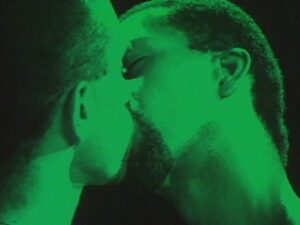RSVP HERE
In conjunction with EMERGENCE: Intersections at the Center, the current exhibition at the South Side Community Art Center, CEREMONIES will be screened IN PERSON, in partnership with South Side Projections.
Co-curator of EMERGENCE and SSCAC Public Programs and Engagement manager zakkiyyah najeebah dumas-o’neal will lead a post-discussion with Aymar Jean Christian, associate professor of communication studies at Northwestern University and co-founder of OTV | Open Television. Aymar also served as an advisory panelist during the organizing phases of EMERGENCE.
A filmmaker unlike any other, Marlon Riggs was an unapologetic gay Black man who defied a culture of silence and shame. Riggs used a bold mix of documentary, performance, poetry, and music to confront the legacy of racist stereotypes and the impact of AIDS on the Black community. He died in 1994 of AIDS-related illness, leaving behind a vital, living body of work that wrestled with the very definition of what it means to be Black.
Marlon Troy Riggs (1957-1994) was an American filmmaker, educator, poet, and gay rights activist. He produced, wrote, and directed several documentary films including Ethnic Notions, Tongues Untied, Color Adjustment and Black Is, Black Ain’t. His films examine past and present representations of race and sexuality in the United States.

CEREMONIES directly references poet Essex Hemphill’s groundbreaking anthology of short stories and poetry Ceremonies: Prose and Poetry, which won the National Library Association’s Gay, Lesbian, and Bisexual New Author Award when it was published in 1992. The book’s poems and essays expand on many important social issues at the time, such as the white objectification of Black men, as epitomized by Robert Mapplethorpe’s The Black Book; AIDS in the Black community; and the complex dynamics gay Black men experience in both the white LGBTQ+ community and in Black culture – very much in alignment with Rigg’s exploration of these topics as it appeared in his film works. In addition Essex Hemphill’s poetry was also featured in Marlon Riggs’ documentaries Tongues Untied (1989) and Black Is … Black Ain’t (1994).
This program features three short films by Marlon Riggs: Affirmations (1990), Anthem (1991), and Regrette Rien (No Regret)(1993), of which depict the visual, artistic, and political convictions of a transformative and pioneering filmmaker whose work is a historical document of Black gay sexuality from a Black perspective and still deeply relevant today.
This program is generously supported by, and in partnership with South Side Projections.
Founded in 2011, South Side Projections presents films at locations across Chicago’s south side to foster conversation about complex social and political issues. At many screenings, we enlist scholars, activists, and filmmakers to lead discussions, while other screenings offer opportunities to present seldom-seen films of historical and artistic value to the communities of Chicago’s south side.




